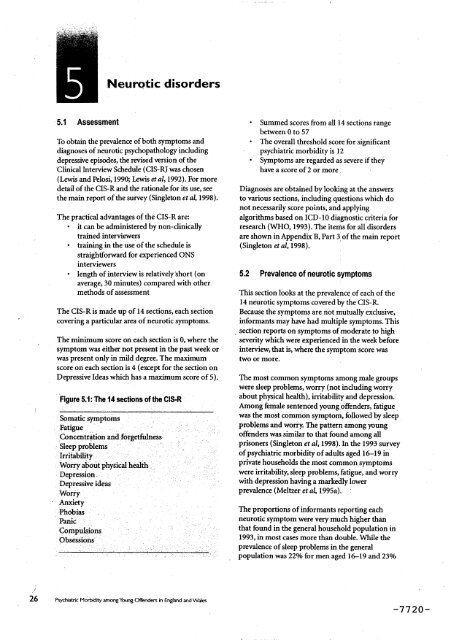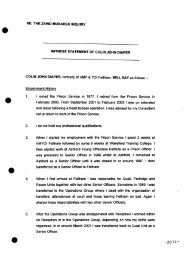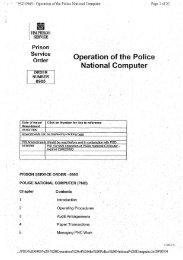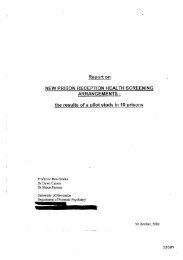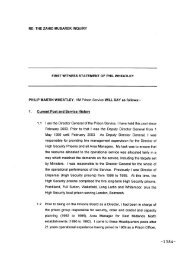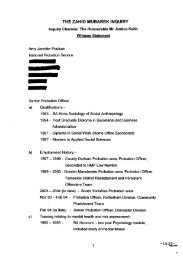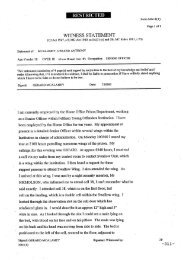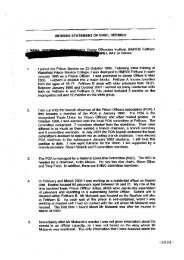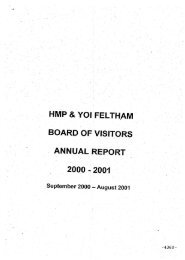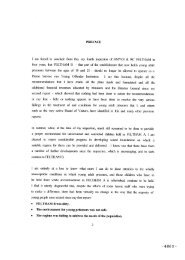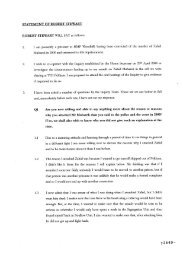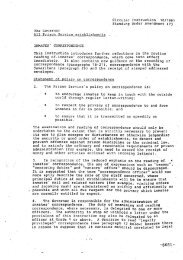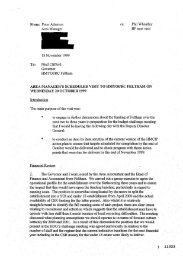Neurotic disorders
Neurotic disorders
Neurotic disorders
You also want an ePaper? Increase the reach of your titles
YUMPU automatically turns print PDFs into web optimized ePapers that Google loves.
<strong>Neurotic</strong><br />
<strong>disorders</strong><br />
5.1 Assessment • Summed scores from all 14 sections range<br />
between 0 to 57<br />
To obtain the prevalence of both symptoms and • The overall threshold score for significant<br />
diagnoses of neurotic psychopathology including psychiatric morbidity is 12<br />
depressive episodes,the revised version of the • Symptoms are regarded as severe if they<br />
Clinical Interview schedule (CIS-R_was chosen<br />
havea score of 2 or more<br />
(Lewisand Pelosi,1990;Lewiset al, 1992).For more<br />
detail of the CIS-R and the rationale for its use, see Diagnoses are obtained by looking at the answers<br />
the main report of the survey (Singleton et al, 1998). to various sections, including questions which do<br />
not necessarily score points, and applying<br />
The practical advantages of the CIS-R are"<br />
algorithms based on ICD-10 diagnostic criteria for<br />
• it can be administered by non-clinically research (WHO, 1993). The items for all <strong>disorders</strong><br />
trained interviewers<br />
are shown in Appendix B, Part 3 of the main report<br />
• training in the use of the schedule is (Singleton et al, 1998).<br />
straightforward for experienced ONS<br />
interviewers<br />
• length of interview is relatively'short (on 5.2 Prevalenceof neurotic symptoms<br />
average, 30 minutes) compared with other<br />
methods of assessment<br />
This section looks at the prevalence of each of the<br />
14 neurotic symptoms covered by the CIS-R.<br />
The CIS-R is made up of 14 sections, each section Becausethe symptoms are not mutually exclusive,<br />
covering a particular area of neurotic symptoms, informants may have had multiple symptoms. This<br />
section reports on symptoms ofmoderate to high<br />
The minimum score on each section is 0, where the severitywhich were experienced in the week before<br />
symptom was either not present in the past week or interview, that is, where the symptom score was<br />
was present only in mild degree. The maximum two or more.<br />
score on each section is 4 (except for the section on<br />
Depressive Ideas which has a maximum score of 5). The most common symptoms among male groups<br />
were sleep problems, worry (not induding worry<br />
Figure511:The14sectionsoftheClS-R<br />
Somatic symptoms<br />
Fatigue<br />
Concentrationand.f0rgetfulness<br />
Sleepproblems<br />
Irritability<br />
Worryaboutphysical health<br />
Depression<br />
Depressive ideas<br />
Worry<br />
Anxiety<br />
Phobias<br />
Panic<br />
Compulsions<br />
Obsessions<br />
...... .... " ( ( ' " " '"'r' ""' "_'' _ population<br />
about physical health), irritability and depression.<br />
Among female sentenced young offenders, fatigue<br />
was the most common symptom, followed by sleep<br />
problems and worry. The pattern among young<br />
offenders was similar to that found among all<br />
prisoners (Singleton et al, 1998). In the 1993survey<br />
of psychiatricmorbidity of adultsaged 16-19 in<br />
privatehouseholds the most common symptoms<br />
were irritability,sleep problems, fatigue, and worry<br />
with depression having a markedly lower<br />
prevalence (Meltzer et al, 1995a).<br />
The proportions of informants reporting each<br />
neurotic symptom were very much higher than<br />
that found in the general household population in<br />
1993, in most casesmore than double. While the<br />
prevalence of sleep problems in the general<br />
was 22% for men aged 16-19 and 23%<br />
26 PsychiatricMorbidity amongYoungOffenders in EnglandandWales<br />
-7720-


